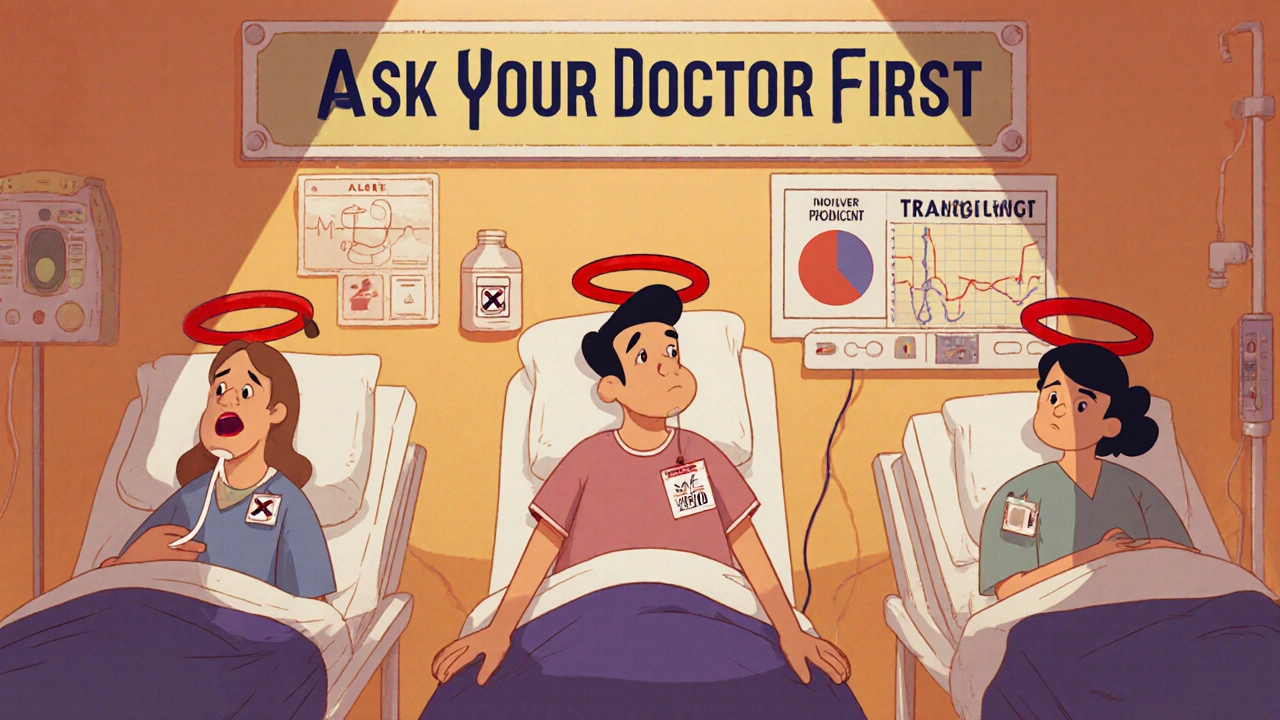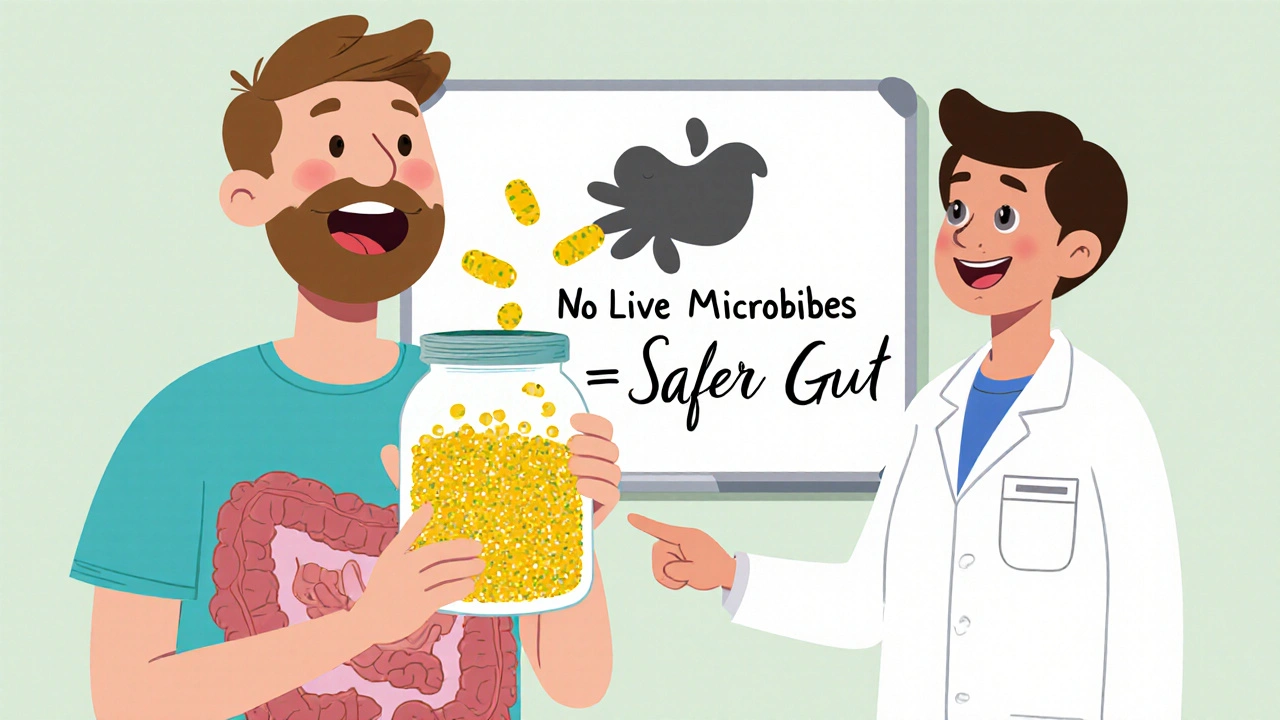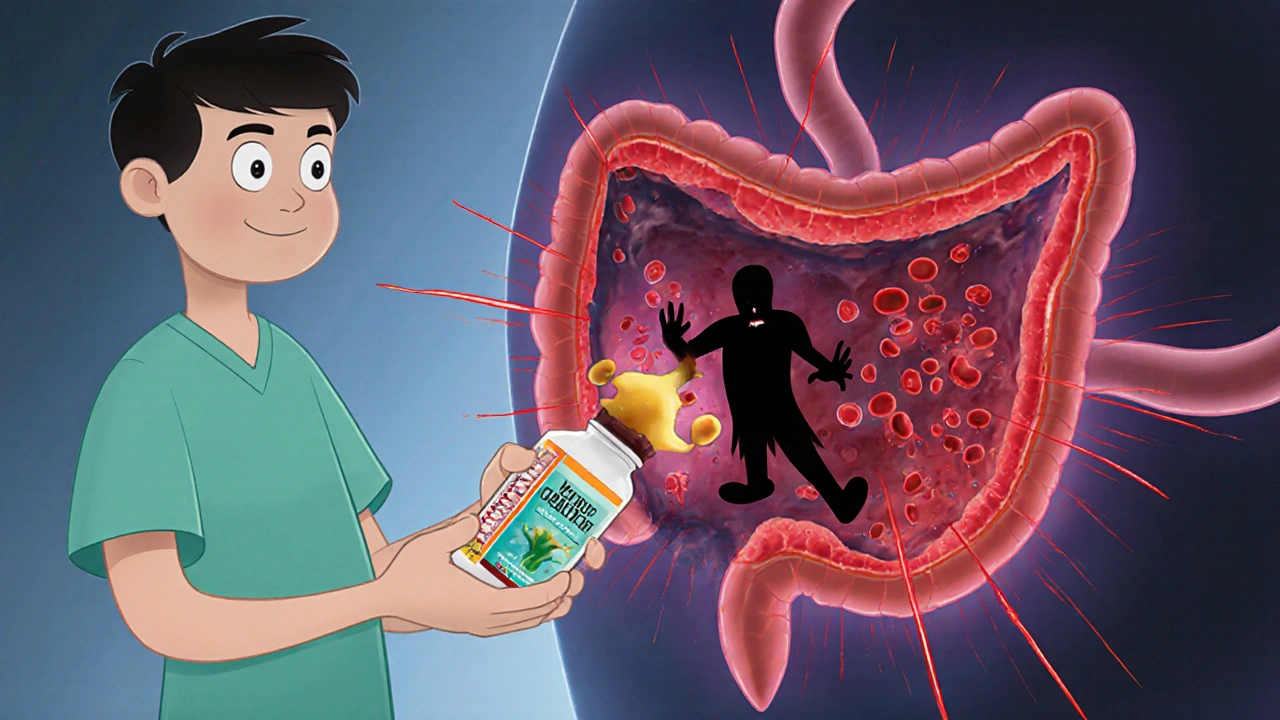Probiotic Safety Calculator
Risk Assessment Tool
Answer a few questions to determine if probiotics are safe for you while taking immunosuppressants.
When you're taking immunosuppressants-whether for a transplant, lupus, rheumatoid arthritis, or cancer treatment-your body is already playing defense against its own immune system. Adding probiotics into the mix might seem like a smart move for gut health, but it can turn into a quiet danger. The truth is, what helps most people’s digestion could put you at serious risk of infection. This isn’t theoretical. People on immunosuppressants have developed bloodstream infections, heart infections, and even died after taking probiotics. The science is clear: probiotics and immunosuppressants don’t always mix safely.
Why Probiotics Can Turn Dangerous
Probiotics are live bacteria or yeast meant to support gut health. Common strains include Lactobacillus, Bifidobacterium, and the yeast Saccharomyces boulardii. In healthy people, these microbes stay mostly in the intestines, helping crowd out bad bacteria and strengthen the gut lining. But when your immune system is turned down by drugs like tacrolimus, cyclosporine, or prednisone, that barrier can fail. The microbes meant to help you can slip into your bloodstream and start growing where they shouldn’t. This isn’t rare. Between 2000 and 2020, 47 documented cases of probiotic-related infections occurred, and 83% of them happened in people with weakened immune systems. The most dangerous offender? Saccharomyces boulardii. In patients with central lines (like those used for IV meds or nutrition), this yeast caused bloodstream infections in 22% of cases. That’s not a small risk-it’s life-threatening.Who’s at Highest Risk?
Not everyone on immunosuppressants is equally vulnerable. Risk depends on what you’re taking, how much, and how your body is responding.- Neutropenia (white blood cell count below 500/µL): This is the highest-risk category. If you’re undergoing chemotherapy and your neutrophils are this low, probiotics are a hard no. Over 87% of U.S. cancer centers ban them during this time.
- Recent organ transplant (first 3 months): Your body is flooded with drugs to stop rejection. During this window, your gut is more porous, and your immune system is at its weakest. A 2020 study found a 4.2-fold higher risk of bacteremia in bone marrow transplant patients using probiotics.
- Central venous catheters: If you have a PICC line or port for medications, Saccharomyces boulardii can cling to it and grow right into your blood. One study showed a 27% higher risk of catheter-related infection.
- Low CD4 count in HIV: If your CD4 is below 100, your risk of fungal infection from probiotics jumps nearly fourfold. Above 200, the risk drops sharply.
Who Might Still Benefit?
There’s one group where the evidence actually supports probiotics: liver transplant recipients. A 2022 meta-analysis showed a 34% drop in bacterial infections when patients used specific strains like Lactobacillus rhamnosus GG. No increase in serious side effects was found. That’s rare. For most other transplant types-kidney, heart, lung-there’s no solid proof of benefit, and plenty of proof of harm. Even in autoimmune conditions like Crohn’s or lupus, results are mixed. One survey of 1,247 patients found 68% reported better digestion with probiotics and no problems. But that’s self-reported. It doesn’t track infections. Meanwhile, case reports show people on methotrexate or biologics developing Lactobacillus bacteremia after taking probiotics for months.
What Strains Are Safer? (And What’s Not)
Not all probiotics are created equal. The strain matters more than the brand.- Avoid: Products containing Saccharomyces boulardii if you’re immunosuppressed. This yeast is the most common cause of fatal infections in this group.
- Use with extreme caution: Multi-strain products. A 2022 study found they had 63% higher risk of translocation than single-strain ones.
- Potentially acceptable (with doctor approval): Single-strain Lactobacillus rhamnosus GG (ATCC 53103) or Bifidobacterium infantis in stable patients with no central lines and CD4 >200.
What Doctors Actually Recommend
The Infectious Diseases Society of America (IDSA) uses a four-tier system to guide decisions:- Category 1 (Highest Risk): Neutropenia, recent stem cell transplant, central lines. Absolute contraindication.
- Category 2 (Moderate Risk): Solid organ transplant within 3 months, multiple immunosuppressants. Only use with infectious disease consultation.
- Category 3 (Lower Risk): Stable autoimmune disease on one drug, CD4 >200. Selective strains only, under supervision.
- Category 4 (Low Risk): No immunosuppression. Standard use is fine.

What to Do If You Already Take Probiotics
If you’re on immunosuppressants and currently taking probiotics, don’t panic-but don’t ignore it either.- Stop immediately if you develop a fever over 101°F (38.3°C), chills, or unexplained fatigue.
- Call your doctor and mention exactly which probiotic you’re taking-brand, strain, and dosage.
- Don’t assume it’s “just a stomach bug.” In immunosuppressed people, a fever can be the first sign of a life-threatening infection.
- Keep a log: When you started, what symptoms you had, and whether you’ve had any infections since.
What’s Coming Next
The field is shifting. Researchers are now looking at “postbiotics”-non-living microbial byproducts like short-chain fatty acids and enzymes. These may offer the gut benefits of probiotics without the infection risk. A 2024 trial showed a 40% drop in C. difficile infections in immunocompromised patients using postbiotics-with zero adverse events. Also, the PROTECT registry is tracking 5,000 patients on immunosuppressants who use probiotics. Early data, expected in 2025, could finally give us clear, personalized guidelines. Until then, err on the side of caution.Final Guidance
If you’re on immunosuppressants:- Don’t take probiotics unless your specialist says it’s safe.
- Avoid Saccharomyces boulardii completely.
- Never use multi-strain products.
- Know your strain. Ask for the ATCC number.
- Monitor for fever, chills, or abdominal pain-act fast if they appear.
- Consider postbiotics as a safer alternative in the future.
Can I take probiotics if I’m on prednisone?
It depends. If you’re on low-dose prednisone (under 10 mg/day) for a stable condition like rheumatoid arthritis and have no other risk factors (like a central line or recent transplant), some doctors may allow a single-strain probiotic like Lactobacillus rhamnosus GG. But if you’re on higher doses, or you’re also taking other immunosuppressants, the risk increases. Always check with your doctor before starting.
Are probiotics safe after a kidney transplant?
No, not in the first 3 months. After a kidney transplant, your immune system is at its most suppressed. Studies show a higher risk of probiotic-related infections during this time. Even after 3 months, most transplant centers recommend avoiding them unless there’s a clear, documented benefit and you’re under close supervision. Lactobacillus strains have caused bloodstream infections in transplant patients-even years after surgery.
What if I’m on chemotherapy?
Avoid probiotics entirely during periods of neutropenia (when your white blood cell count is below 1,000/µL). This is standard practice at 87% of U.S. cancer centers. Even after your counts recover, many oncologists still advise against them due to the risk of delayed infections. If you’re struggling with chemo-related diarrhea, ask about alternatives like fiber supplements or prescription medications like loperamide.
Is there a probiotic brand that’s safe for immunosuppressed people?
There’s no brand that’s universally safe. What matters is the strain, not the label. Some products claim to be “medical-grade,” but that’s not regulated. Only a few strains-like Lactobacillus rhamnosus GG ATCC 53103-have been studied in immunocompromised patients. Even then, safety depends on your individual condition. Always get the exact strain name and ATCC number from your doctor before using any product.
Can probiotics cause sepsis in immunosuppressed patients?
Yes. Probiotics have caused sepsis in people on immunosuppressants. Documented cases include Lactobacillus rhamnosus GG and Saccharomyces boulardii entering the bloodstream and triggering septic shock. In one review, 36% of these infections resulted in death. The risk is small in absolute terms-but for someone with a suppressed immune system, even a 0.1% chance is too high.
What should I do if I accidentally took a probiotic?
Stop taking it immediately. Monitor yourself for fever, chills, nausea, or unusual fatigue over the next 72 hours. If any of these appear, go to the ER and tell them you took a probiotic while on immunosuppressants. Bring the bottle with you. Early detection is critical-blood cultures can confirm if the probiotic strain is causing an infection. Don’t wait for symptoms to get worse.


Jillian Fisher
October 28, 2025
I’ve been on prednisone for lupus for five years and never thought twice about my daily probiotic. Now I’m freaking out a little. I took L. rhamnosus GG because the bottle said ‘for immune support.’ Turns out that might’ve been the worst possible reason to take it.
Should I get bloodwork just to be safe? I haven’t had a fever, but I’ve been more tired than usual lately. Is that just the meds or something worse?
Rachel Marco-Havens
October 30, 2025
People are still taking probiotics like they’re gummy vitamins? Wow. You think your gut is some kind of sacred temple that needs cheering up with live bacteria? Newsflash-your immune system isn’t broken because you didn’t eat enough yogurt. It’s suppressed because you have a disease that’s trying to kill you.
Stop treating your body like a pet rock you can sprinkle fairy dust on. This isn’t wellness influencer content. This is medicine. And if you’re dumb enough to pop a probiotic while on immunosuppressants, you deserve whatever happens to you.
Also Saccharomyces boulardii is a yeast. Not a vitamin. Not a supplement. A living fungus. You wouldn’t drink moldy milk. Why would you swallow moldy bugs?
Kathryn Conant
October 30, 2025
Let me tell you something-your gut is your second brain and if you’re not nurturing it, you’re basically handing your immune system a knife and saying ‘go ahead, stab yourself.’
But here’s the truth: not all probiotics are created equal. I’ve been on methotrexate for RA for six years and I only use L. rhamnosus GG ATCC 53103. No multi-strain nonsense. No fancy labels. Just the strain my doctor approved. I’ve had zero infections. Zero. And my digestion? Smooth as silk.
Don’t let fear paralyze you. Be informed. Be precise. And don’t trust some random guy at the vitamin store who says ‘this one’s good for everyone.’ He doesn’t know your CD4 count. I bet he doesn’t even know what CD4 means.
Knowledge is power. And power means living longer.
j jon
October 30, 2025
I’m on tacrolimus after a liver transplant. My doctor said I can take the GG strain. Said the data supports it. I’ve been on it for a year. No issues.
Just make sure you’re talking to the right person. Not the pharmacist. Not your friend on Reddit. Your transplant team.
Jules Tompkins
October 30, 2025
So let me get this straight-your body’s so weak it can’t handle a friendly bacteria… but it’s fine with a whole pharmacy of synthetic drugs that cost more than my rent?
Feels like we’re being told not to touch a leaf because the forest might be watching.
I get the science. I really do. But this whole thing smells like Big Pharma doesn’t want you to fix your gut naturally because then you wouldn’t need their $200/month pills.
Also-postbiotics? That sounds like science fiction. Are we just gonna replace bacteria with chemical soup now? What’s next-vitamin IV drips in the shower?
Wiley William
October 31, 2025
Probiotics are a scam. The FDA doesn’t regulate them because they’re owned by the same people who run the CDC and the WHO. They want you to think you need supplements because they’re selling you a false sense of control.
And that ‘Saccharomyces boulardii’ thing? That’s not a yeast. That’s a bioweapon they let slip into the market because they knew people like you would take it. Look at the dates-2000 to 2020. Coincidence? Or did they wait until enough people were on immunosuppressants to test it?
Also-why do all the ‘safe’ strains have ‘GG’ in them? That’s not a strain. That’s a code. Like a military designation. They’re hiding something.
And why does every hospital now require ‘approval’? Because they’re scared you’ll find out the truth. Don’t be fooled. Your gut doesn’t need help. It needs silence.
Richard H. Martin
November 1, 2025
Probiotics? In AMERICA? Are you kidding me? We have the best doctors, the best hospitals, the best science-and yet we’re letting people swallow random bacteria like it’s a cereal topping? This is why America’s healthcare is in shambles! You want to fix your gut? Eat real food. Stop buying junk from Amazon labeled ‘natural’ with a picture of a smiling banana!
And who let this ‘Saccharomyces boulardii’ nonsense get approved? That’s not a probiotic-that’s a foreign invader! We don’t let aliens into our country-and we shouldn’t let them into our bloodstreams either!
Stop the madness. Stop the supplements. Stop the lies. America needs to take back its gut health-before it’s too late!!
Vishnupriya Srivastava
November 2, 2025
The meta-analysis on liver transplant patients shows a 34% reduction in infections-but the sample size was 147. The rest of the data is case reports and retrospective reviews. No RCTs with hard endpoints. The risk-benefit ratio is still undefined for 98% of the population.
Also, ‘postbiotics’ are not a cure. They’re a hypothesis with early phase data. You’re not ‘safe’ because a 2024 trial showed zero adverse events. That’s 40 patients. Not 40,000.
Don’t mistake cautious optimism for clinical consensus. This isn’t a nutrition blog. It’s immunology. And immunology doesn’t forgive mistakes.
Dale Yu
November 2, 2025
I don't care what the science says. I took probiotics for years while on azathioprine and I feel better. My stomach doesn't hurt. My energy is up. My wife says I'm less grumpy. So what if some guy in a lab got sick once? That's not me. I'm not a statistic. I'm a person. And I'm not giving up my yogurt pills just because some doctor thinks I'm dumb.
Also I read on a forum that probiotics cure cancer. Maybe they do. Maybe the whole thing is a lie. Who knows? But I'm not scared of bacteria. I'm scared of being miserable.